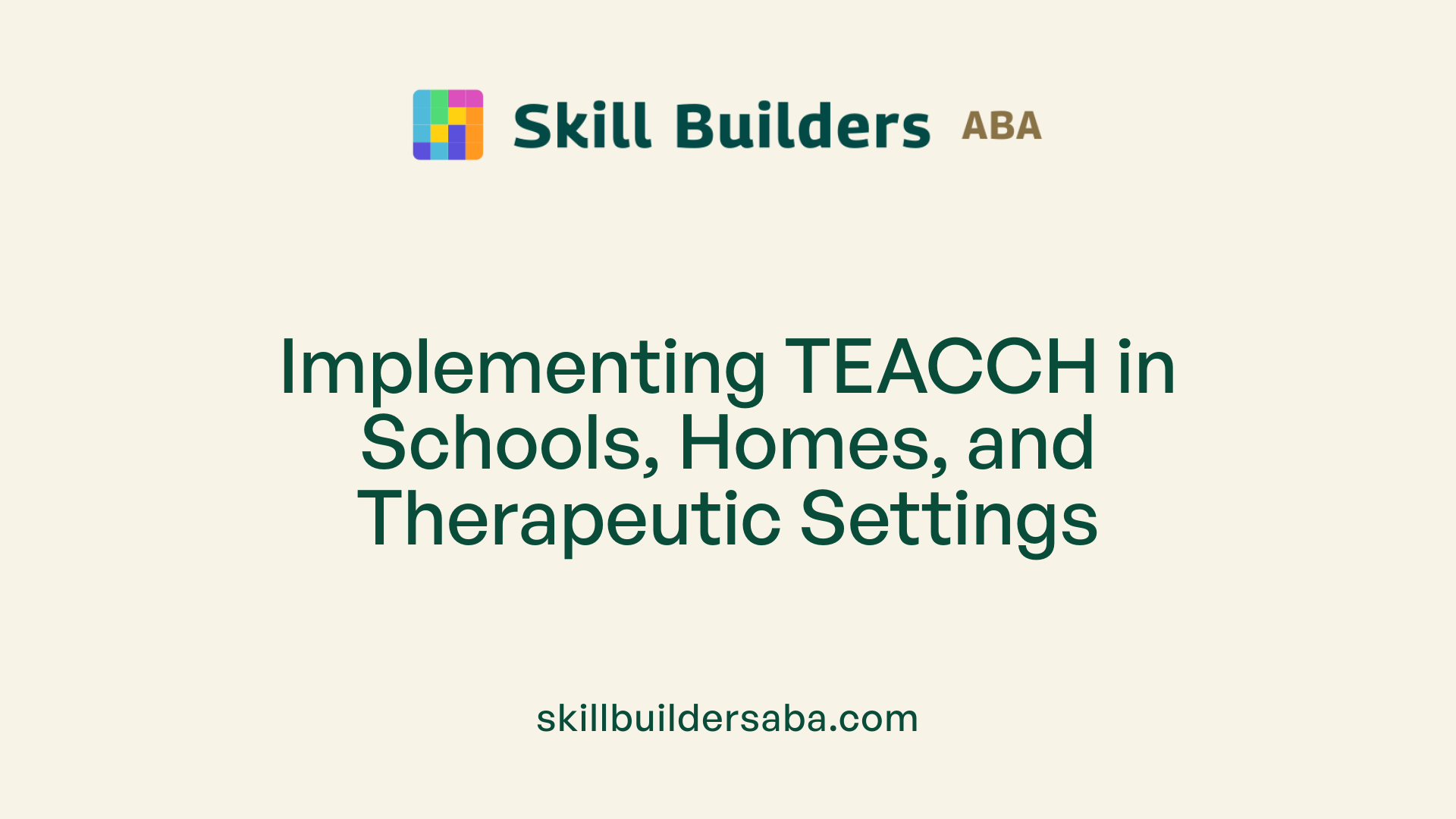TEACCH Method For Autism
Unlocking Independence in Autism Support

Understanding the Foundations of the TEACCH Method
The TEACCH method, a pioneering approach rooted in the principles of structured teaching, has transformed the landscape of autism support and education worldwide. Developed at the University of North Carolina in the 1960s, this evidence-based program emphasizes visual supports, organized environments, and adaptable routines. Its core goal is to promote independence, enhance communication, and improve functional skills across the lifespan of individuals with autism. This article explores the origins, principles, applications, outcomes, and resources associated with TEACCH, offering comprehensive insights into its role in fostering positive development in autistic individuals.
Historical Development and Core Philosophy of TEACCH

Origins and founders
The TEACCH® Autism Program was created at the University of North Carolina—Chapel Hill during the 1960s. It was developed by Dr. Eric Schopler and Dr. Robert Reichler, who aimed to create a structured approach tailored to individuals with autism. Their work laid the foundation for what would become a widely respected model for autism support worldwide.
Development timeline
Initially conceived as a research project in 1964, the program was formally established as the TEACCH® program in 1972. It evolved from early experimental methods inspired by practices in the UK into a comprehensive, evidence-based intervention. Over the years, it expanded beyond clinical services into training, consultation, and research initiatives, helping professionals and families better support individuals with autism across their lifespan.
Core principles and philosophy
The core of TEACCH is understanding autism as a lifelong condition that combines strengths with challenges. The approach emphasizes structured teaching with key principles:
- Organizing physical environments to minimize distractions
- Using visual supports like schedules, cues, and instructional aids
- Establishing predictable routines with some flexibility
- Creating visual work systems that help individuals understand tasks and stay focused
- Building independence through clear expectations and consistent routines
Through these strategies, TEACCH aims to reduce anxiety, promote functional skills, and foster independence for people with autism. It recognizes each individual’s unique needs and tailors interventions accordingly, facilitating learning and development throughout all stages of life.
Principles and Core Strategies of TEACCH
 The TEACCH approach is built on fundamental principles that prioritize structured support tailored to individuals with autism. Central to these principles is the organization of the physical environment. Classrooms and learning spaces are arranged with clear boundaries, visual cues, and minimal distractions to foster a sense of predictability and safety.
The TEACCH approach is built on fundamental principles that prioritize structured support tailored to individuals with autism. Central to these principles is the organization of the physical environment. Classrooms and learning spaces are arranged with clear boundaries, visual cues, and minimal distractions to foster a sense of predictability and safety.
A key component involves establishing routines that are predictable yet flexible enough to accommodate individual needs. Visual, verbal, or written cues and schedules help children understand daily expectations and transitions, reducing anxiety and promoting independence.
Visual supports are essential tools across the TEACCH method. These include visual schedules, social stories, and cues, which aid comprehension and communication for individuals with varying language skills. The use of visual aids not only clarifies tasks but also encourages autonomy.
TEACCH strategies further encompass structured work and activity systems, which break down tasks into manageable steps with visual instructions. These systems help individuals stay focused and understand sequences, fostering a sense of achievement.
Flexibility within routines is also emphasized, allowing children to adapt gradually and build resilience. This balance of predictability and adaptability helps diminish stress and supports learning.
Assessment and personalization are ongoing processes in TEACCH. Professionals conduct evaluations to identify individual strengths and areas for growth, shaping tailored intervention plans. Collaboration between families and educators ensures consistent application of strategies across settings.
Together, these principles and strategies form a comprehensive framework that promotes independence, improves social and communication skills, and enhances overall well-being for individuals with autism. Implementing a well-organized, visually structured environment, alongside flexible routines and continuous assessment, characterizes the TEACCH method’s success.
Applications of TEACCH in Autism Support and Education
 The TEACCH method finds extensive use across various environments to support individuals with autism. It is primarily utilized in classroom settings, where trained educators and therapists incorporate visual schedules, structured routines, and organized physical spaces to foster learning and reduce anxiety. These strategies help children and adults with ASD develop skills in communication, daily living, and social interactions.
The TEACCH method finds extensive use across various environments to support individuals with autism. It is primarily utilized in classroom settings, where trained educators and therapists incorporate visual schedules, structured routines, and organized physical spaces to foster learning and reduce anxiety. These strategies help children and adults with ASD develop skills in communication, daily living, and social interactions.
Beyond schools, TEACCH can be implemented in home environments. Parents work alongside professionals to establish visual supports and routines that reinforce skills learned in educational settings, promoting consistency and skill generalization. This integration helps maintain progress and supports independence in daily activities.
TEACCH is also flexible enough to collaborate with other therapeutic approaches. For example, it is often combined with behavioral therapies to address specific developmental needs, creating a comprehensive support plan tailored to each individual.
The program can serve different age groups, from young children to adults, adapting its strategies to meet changing developmental requirements. Its core principles—visual supports, environmental organization, and predictable routines—are effective across these stages.
Professionals trained in TEACCH, including teachers, psychologists, and speech therapists, play a crucial role in delivering these services. They use evidence-based practices to create supportive environments that enhance learning, social engagement, and independence.
Research on TEACCH’s effectiveness shows moderate improvements in cognition, social skills, and adaptive behaviors, especially in school-age individuals and adults with milder intellectual disabilities. Its adaptability and evidence base make it a cornerstone in autism education and support strategies worldwide.
Overall, TEACCH’s versatile applications and focus on individualized, visual, and organized approaches make it a valuable framework in fostering growth and independence for people with autism across settings and life stages.
Evidence, Effectiveness, and Resources for TEACCH

How effective is the TEACCH approach?
Research supports the positive impact of the TEACCH method on individuals with autism spectrum disorder (ASD). Multiple studies have documented significant improvements in behavioral, social, and adaptive skills, including language development, imitation, perception, and social communication.
Notably, eleven out of fourteen studies reviewed showed statistically significant reductions in maladaptive behaviors such as stereotyped and repetitive patterns. While much of the research has focused on children with high-functioning autism or no intellectual disabilities, recent findings suggest TEACCH's benefits extend to young adults with ASD and mild to moderate intellectual disabilities.
Parents and teachers also report decreased stress levels when using TEACCH strategies. The program has gained international recognition for its broad applicability, demonstrating its effectiveness across various settings and populations. Although results can vary based on processes and individual differences, the evidence overall affirms TEACCH as a valuable intervention.
What training resources and certification opportunities are available?
The TEACCH Autism Program provides comprehensive training options for professionals and families. Certification levels include the TEACCH® Certified Practitioner, which requires a five-day training, participation in seminars, and passing an exam supported by a portfolio review. Certification lasts for three years and can be renewed through continuous professional development.
Additional offerings include online courses, webinars, and specialized training sessions like Family Implemented TEACCH for Toddlers. Certified practitioners gain access to a wealth of resources, materials, and expert consultation. The Autism Speaks Directory assists in locating trained TEACCH professionals regionally.
These training initiatives aim to support high-fidelity implementation of TEACCH strategies, ensuring maximum benefit for individuals with autism.
What are some of the notable research outcomes supporting TEACCH?
Research studies demonstrate the effectiveness of TEACCH in promoting important developmental skills. For example, an experimental study with young adults having ASD and mild to moderate intellectual disabilities involved a 20-session TEACCH-based training program.
Results showed notable improvements in functional skills and in Goal Attainment Scaling scores, indicating progress toward individualized goals. Although some assessments like the TEACCH Transitional Assessment Profile (TTAP) showed no significant change, overall findings endorse TEACCH’s ability to teach targeted skills.
Supporting evidence from a 2011 review emphasizes TEACCH’s proven educational benefits—including gains in cognition and motor skills. Despite some limitations such as small sample sizes in certain studies, the overall data affirms the positive influence of TEACCH on behavioral and social outcomes, solidifying its role in autism interventions.
Looking Towards a Brighter Future with TEACCH
The TEACCH method has established itself as a cornerstone of autism support through its emphasis on structure, visual supports, and individualized planning. Its wide array of applications—from homes to classrooms and clinics—demonstrates its flexibility and effectiveness, helping many individuals with autism achieve greater independence and quality of life. Continued research, training, and community engagement will further enhance its impact, fostering a future where autistic individuals are supported in reaching their full potential. As a recognized evidence-based approach, TEACCH will remain a vital part of autism intervention strategies worldwide, inspiring new innovations and collaborative efforts to promote inclusive, supportive environments for all.
References
- TEACCH - Autism Speaks
- TEACCH® Autism Program: Home
- Understanding and Utilizing the TEACCH Method
- [PDF] TEACCH
- About Us - TEACCH® Autism Program
- TEACCH autism program: a guide | Raising Children Network
- Teaching Materials - TEACCH® Autism Program
- Treatment and Education of Autistic and Related Communication ...
- TEACCH® Certification Program
.svg)














